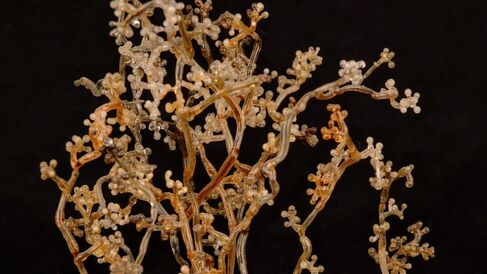Glass Models of Fungi

Dr. William A. R. Dillon Weston, a fungus expert at the University of Cambridge, demonstrated the structures of extremely small fungi using his own hand-made glass models. His models show fungi that cause diseases in plants, including the potato blight fungus and moulds found on bread and vegetables.
Fungi down the microscope
Trying to identify fungi and moulds that attack food crops can be a difficult task. The more quickly a type of fungus is identified, the more quickly the crops can be treated.
Dr. William Dillon Weston (1899-1953) was a mycologist (a fungus specialist) working for the Ministry of Fisheries in Cambridge in the 1930s. He came up with an inventive way to demonstrate what extremely small fungi looked like when viewed with a microscope. Instead of referring farmers to pictures of fungi, Dr. Dillon Weston made models of them using glass.
Dr. Dillon Weston's glass models were all made between 1936 and 1953. The particular fungi that he focused on were those that cause diseases in plants, which are normally only visible using a microscope. As well a being a useful demonstration tool, the models are also particularly beautiful.
Types of glass fungi
The majority of the models illustrate microscopic disease-causing fungi, modelled at a magnification of between 20-600 times. They include common moulds found on bread and vegetables, fruit rots and diseases of potatoes, wheat and brassicas. Generally, this type of model was made using clear, uncoloured glass, as the fungi are transparent or hyaline in nature. Coloured glass was used where necessary, such as for dark spores. These models are often extremely fragile objects.
The other group of models include larger fungi and vegetables that are being attacked by fungal growths, all of which are modelled at approximately natural size. Dillon Weston made these models from opaque, coloured glass, and they are much sturdier than the transparent type.
Only one other collection of glass fungi models is known - part of the The Ware Collection of Blaschka Glass Models of Plants in the Harvard Museum of Natural History, Cambridge, Massachusetts.
Dr. Dillon Weston: Fungus Expert and Model Maker
As well as creating useful demonstration tools, Dillon Weston's model making hobby was a remedy for his bouts of insomnia. Some of these delicate objects were produced on family holidays and then transported back to Cambridge in the back of his car.
Fungus expert
Dr. Dillon Weston (1899-1953) spent all of his professional life in Cambridge. After obtaining his degree in Natural Sciences at St. Catharine's College, Dr. Dillon Weston was employed as a mycologist (an expert in the study of fungi) at the Ministry of Agriculture and Fisheries. Ministry pathologists at that time were stationed at universities, where teaching and supervision of students were included as part of their duties.
Model maker
Dr. Dillon Weston began making models in glass in 1936, mostly of fungi that cause plant diseases. His tools for making the models were simple: a Bunsen burner; pliers and imported glass from Czechoslovakia. The majority of the models were made during the early hours of the morning at his home, Howe Farm in Cambridge. He suffered from insomnia and found that his model-making provided some relief. As Dr. Dillon Weston became more enthusiastic about his hobby, he also produced some delicate pieces during summer vacations to Frinton-on-Sea with his family between 1937 and 1939. These fragile models then had to make a careful journey back to Cambridge by car.(1)
Dr. Dillon Weston made fewer models during the war years as he became progressively busier. He was appointed as Principal Plant Pathologist for the Eastern Province of the National Agricultural Advisory Service in 1946. Dr. Dillon Weston died in 1953 aged only 54.
References
- H. Tribe, 'The Dillon-Weston glass models of microfungi', The Mycologist, vol 31 (1998), pp. 169-173.
Ruth Horry
Ruth Horry, 'Glass models of fungi', Explore Whipple Collections, Whipple Museum of the History of Science, University of Cambridge, 2008.
